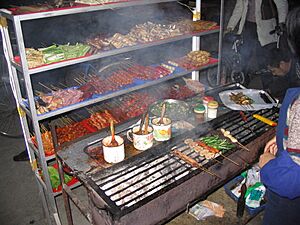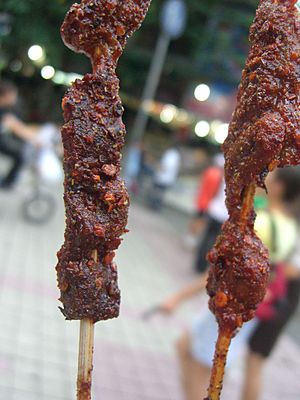Shaokao facts for kids

Shaokao (traditional Chinese: 燒烤; simplified Chinese: 烧烤; pinyin: shāo kǎo), also known as shao kao, is the Chinese word for "barbecue". It's a big part of Chinese cooking. In China, you'll often find shaokao on busy streets and at night markets. It's a popular street food sold from food stalls, a type of xiaochi (small snack). People often enjoy shaokao with beer, both in China and other places like the United States.
Shaokao usually features foods cooked on skewers, covered in lots of spices. You can find it in almost every city in China. It's especially popular in Beijing, where some restaurants even set up outdoor stalls to sell it. Sometimes, there are rules about outdoor shaokao because of concerns about smoke affecting the air.
Contents
What are Kaochuan or Yangrouchuan?
A main type of shaokao is "Yangrouchuan" or "kaochuan." These are usually heavily spiced foods cooked on skewers. In China, mutton skewers (called kǎochuàn in Chinese or kawap in Uyghur) have a very long history.
People have found evidence of meat skewers from long ago. For example, archaeologists found meat skewers in a tomb from around 2012. There's even a painting from the Liao dynasty showing people eating skewers. However, in modern times, skewers became really popular across China starting around the 1980s, spreading from the Xinjiang region.
Often, places that sell skewers also sell other grilled foods. So, "skewers" can sometimes mean all kinds of grilled dishes. The most common type of skewer is lamb, so "kebabs" are often used to mean "skewers." Eating skewers is simply called "eating barbecue." The style of skewers can be different depending on local traditions and groups of people.
A Look Back in Time: Shaokao History
People believe that kebabs or shaokao started with nomadic groups, who often moved from place to place. We don't know exactly when they first appeared, but they have been around for a very long time. About 1800 years ago, there was already kebab in China. An old stone carving from the Han Dynasty shows people eating kebabs. A barbecue fan was even found in an ancient tomb!
In the 1980s, archaeologists found two more stone carvings of kebabs from the late Han dynasty. These carvings showed Chinese people grilling beef and mutton. This shows that kebabs were a part of everyday life in that area 1800 years ago. The carvings even show special tools, like two-pronged forks, used for grilling. This suggests that kebabs have a long history in different parts of China, not just in one specific region like Xinjiang.
Over time, barbecue cooking methods improved. In the early Ming dynasty, people would cut beef into cubes and soak them in spices before cooking. Later, during the late Ming and early Qing dynasty, Mongolian people cooked large pieces of beef and mutton over fires. By the 1800s, barbecue had become very popular and delicious, with poets even writing about how wonderful it tasted.
How Shaokao is Made
Shaokao is made with meats, fish, seafood, and vegetables. These are put on bamboo skewers and cooked over a flame on a barbecue. Before cooking, they are heavily seasoned with different spices, like cumin and Chinese five-spice powder. The skewers are cooked fresh when you order them. You can also find grilled Barbecue chicken legs and spare ribs as part of shaokao meals.
Shaokao in Beijing
In Beijing, shaokao is a very common and popular food. Some restaurants in Beijing set up barbecue stands outside to sell to people walking by. Sometimes, people who operate these stands are migrant workers. Neighbors in Beijing sometimes complain about the smoke and smell from outdoor barbecue stands. They also worry about food safety. In 2013, outdoor barbecue stands were banned in Beijing because of heavy smog. Chinese officials said that shaokao and fireworks were a big reason for the smog in Beijing.
Shaokao in Xinjiang
Xinjiang is one of the main places in China where kaochuan is made. Sheep meat is very important for the people who live there. Sheep in Xinjiang eat grass in natural fields and grow up in the mountains. They are healthy and drink clean spring water. For roast lamb skewers, lamb that is about 2 years old is often chosen because its meat is tender and juicy.
Here's a simple way to make lamb skewers:
- Ingredients: Lamb leg, cooking wine, salt, pepper, soy sauce, vegetable oil, cumin, chili powder, white sesame.
- Steps:
1. Cut the lamb leg into medium-sized pieces. 2. Put the lamb in a box and add wine, salt, soy sauce, and pepper. Mix it all well and let it sit for at least 30 minutes. Add a little oil before cooking. 3. Mix again so each piece of meat has a thin layer of oil. Put the lamb pieces onto bamboo skewers. 4. Preheat an air fryer to 200°C (about 390°F) and cook the lamb kebabs for 5 to 10 minutes.
Where to Find Shaokao
You can find Shaokao in almost every city in China. They are often located along streets that have many bars. In China, some shaokao food stalls also sell other items like fresh produce, which they display hanging on sticks. In both China and the United States, some restaurants focus only on shaokao dishes.



